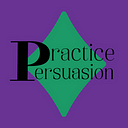Advertisment and Rhetoric Manipulation Hidden Beneath It
As you might know or not, I’m studying rhetoric and form of it mostly focused in public speeches.
While studying, I’m now discovering how much of the persuasive tacting they’re using only to gain more customers.
Of course don’t take this as something illegal.
Many agencies who creates ads for big companies doesn’t hide that all they’re working on is some kind of manipulation whatsoever.
However, it is crucial to identify what manipulation actually is to not draw hasty conclusions.
There are many lectures how to differentiate manipulation and persuasion but here’s a small cheat sheet for you, just for start if you’re a beginner.
But without further ado let’s see what persuasive tactics are being used in advertising.
PS. This is only for rhetoric part of ads.
In the future I’ll discuss more parts such as body language because this is such a wide topic.
1. Repetition
“When something is told the first time, it is a revelation.
When something is told the second time, it is a confirmation.
But when something is told the third time, it is an affirmation.”
Repetions used in ads are a really powerful tool, even we use it in normal conversation.
The point of repetition is to :
- Emphasize the urgency
- Show importance of it
- Enhance memorability
- Highlight good aspects
- Hold the attention and engagement
Examples of repetition used in advertisements:
“Open happiness. Open happiness. Open happiness”
Coca Cola Year 2009
“I’m lovit’ it. I’m lovit’ it. I’m lovit’ it”
McDonald’s Year 2003
2. Hyperbole
This particular figure involves exaggeration for dramatic effect or emphasis.
It is commonly used in advertising to:
- make a product or service stand out
- create an attention-grabbing image
- emphasize pros of the product
- make the product more desirebale
Here are few examples:
“Melts in your mouth, not in your hands.”
M&M’s
“Red Bull gives you wings.”
Red Bull
“Because you’re worth it.”
L’Oréal
3. Rhetorical Question
A question asked for effect, not requiring an answer.
Rhetorical question are designed for one of these aspects:
- Create a sense of involvement
- Make the audience reflect
- Highlighting pros
- Create curiosity
Examples of rhetorical questions:
“What will you do to #justdoit ? “
Nike
“Where’s the beef ? ”
Wendy’s
“What does 100% pure orange juice taste like ?”
Tropicana
“Can a car be a soulmate ? “
Audi
4. Emotional Appeal
Emotional Apeeal more known as pathos in rhetoric.
It could occur as a form of personification as well, by giving items human characteristic.
Most important, it evokes our feelings and for instance if someone says “cozy blanket” we’ll imagine this product with the warmth and familiarity of home.
Emotional Appeal is designed for one of this purposes:
- Forge Emotional Connections
- Enhance Memorability
- Influence Decision-Making
- Differentiate from Competitors
Examples from big companies
Loretta ← — — Click the Link, to see the video
Google
#LikeAGirl ← — — Click the Link, if you want to see it
Always
Share a Coke ← — — Click the Link, for video
If you’ve enjoyed it and learn something new, then I’m really happy :)
Have a nice day everyone, who reads it.
